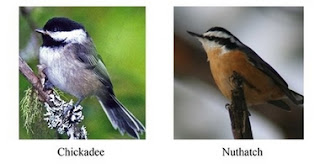This morning I birded at the National Arboretum. I was looking for some specific early-spring migrants, so I started out in the state tree grove. This is an area with lots of pines, and so it frequently has a pine warbler or two in March and April. Sure enough, there was one singing, but it would not show itself.
While the pine warbler made itself invisible, other birds let themselves be seen. In particular, there were a lot of northern flickers hanging around the state tree grove and picnic area. When I say "a lot," I mean something like two dozen. There were flickers on the ground, there were flickers in the trees, there were flickers in flight, there were flickers everywhere I looked. These must have arrived in a major wave last night. There was a native plant symposium today, so the grounds were more crowded than usual, mainly around the visitor center where there was a plant sale. Fortunately, the Arboretum is large enough that I can bird in relative peace despite the presence of a busy symposium. The species count is a little low today because I focused my attention on a few less birdy areas to look for specific birds.
There was a native plant symposium today, so the grounds were more crowded than usual, mainly around the visitor center where there was a plant sale. Fortunately, the Arboretum is large enough that I can bird in relative peace despite the presence of a busy symposium. The species count is a little low today because I focused my attention on a few less birdy areas to look for specific birds.
SPECIES SEEN: 28
Canada Goose
Mallard
Turkey Vulture
Red-tailed Hawk
Ring-billed Gull
Rock Pigeon
Mourning Dove
Yellow-bellied Sapsucker
Downy Woodpecker
Northern Flicker
Pileated Woodpecker
Eastern Phoebe
Golden-crowned Kinglet
Northern Mockingbird
Eastern Bluebird
American Robin
Carolina Chickadee
Tufted Titmouse
Blue Jay
European Starling
Pine Warbler
Eastern Towhee
Chipping Sparrow
Song Sparrow
Dark-eyed Junco
Northern Cardinal
Common Grackle
Brown-headed Cowbird






_sm.jpg)

























